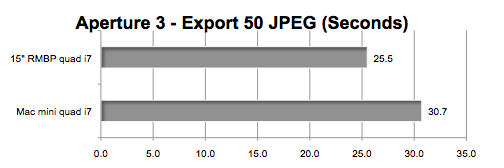Some readers are asking if the 'late 2012'
Mac mini with a Quad-Core i7 processor can match the performance of a 'late 2012' iMac with Quad-Core i7 processor when running real world applications. Since the 2012 iMac isn't available yet, we decided to use a 'surrogate': the 2012 Retina 15" MacBook Pro which has similar "guts" -- an 'Ivy Bridge' Quad-Core i7 and discrete GeForce GT 650M GPU.
Now the 'late 2012' iMac with the 21.5" screen will have a Quad-Core i7 'Ivy Bridge' processor running at a higher clock speed (3.1GHz) than the RMBP, but it will have the same GPU (GeForce GT 650M). Plus the 2.7GHz RMBP has a core clock speed very close to our 2.6GHz Mac mini test unit. Therefore we believe some insights can be gained by the Mac faithful trying to decide whether to jump on the Mac mini to run their pro apps or sit tight until the 'very late 2012' iMac ships.
GRAPH LEGEND
15" RMBP quad i7 = 2012 Retina MacBook Pro with 2.7GHz Quad-Core i7 CPU and GeForce GT 650M GPU -- (Surrogate for the soon-to-be released 21.5" iMac with similar specs)
Mac mini quad i7 = 2012 Mac mini with 2.6GHz CPU Quad-Core i7 and integrated Intel HD 4000 GPU
Adobe Photoshop CS6 uses OpenCL acceleration on certain filters like Field Blur, Iris Blur, and Tilt/Shift. The OpenCL advanced setting is grayed out in the case of the Mac mini so its CPU has to do the heavy lifting. (LOWER number in seconds is FASTER)

A Photoshop CS6 filter that's more CPU intensive is "Reduce Noise." The mini does better on this test -- actually beating our RMBP. (LOWER number in seconds is FASTER)

Apple Final Cut Pro X leans hard on the GPU when rendering the Directional Blur effect on our sample project made up of eight HD clips. (LOWER number in seconds is FASTER)

Apple Aperture 3's first task was to convert 50 RAW images to original size JPEG and export them. (LOWER number in seconds is FASTER)

Noise Ninja is a Plugin for Aperture for removing noise and grain from digital photographs. It is a must-have tool for anyone shooting in low-light or fast-action situations. We applied it to 50 RAW images of a Soccer match. (LOWER number in seconds is FASTER)

Apple Motion 5 attempts to playback a project while rendering on the fly. The weak GPU of the Mac mini is apparent here. It is not able to maintain the "real time" frame rate of 29.9 FPS. (HIGHER number in Frames per Second is FASTER)

One way to get the Mac mini to playback the project in real time is to pre-render the 600 frames in RAM. You have to have at least 12GB of RAM to render all 600 frames in RAM. Both test units had 16GB of RAM so that wasn't an issue. The Mac with the "real" GPU pre-renders twice as fast as the mini. (HIGHER number in Frames per Second is FASTER)

ANALYSIS
The 'late 2012' Quad-Core i7 Mac mini is a true contender when it comes to CPU power.
However, the Intel HD 4000 GPU in the 'late 2012' Mac mini is weak in comparison to the Retina MacBook Pro (and vicariously, the 2012 iMac with 21.5" screen). This weakness is clearly seen in the GPU intensive Photoshop CS6 "Iris Blur," Final Cut Pro X "Directional Blur," and Motion 5 "Playback" and "RAM Preview" tests. Though not included in this test session, Premiere Pro CS6 and After Effects CS6 also have functions that benefit from a fast standalone GPU. If you make heavy use of those apps, consider yourself warned.
The GPU performance gap will grow even more if instead of the 21.5" screen, you choose the 'late 2012' iMac Quad-Core i7 with the 27" screen. It offers the choice of a GeForce GTX 675MX or GTX 680MX GPU. And, no, you can't speed up the Mac mini with an external GPU inside a Thunderbolt expansion chassis.
Other factors to consider besides speed when deciding between the new Quad-Core Mac mini and the new Quad-Core iMac:
- The new Mac mini can be easily expanded by the user to 16G of RAM. The new 21.5" iMac has memory soldered to the main logic board. There is no user accessible upgrade option. Only the 27" iMac has the four memory slots for user RAM upgrades up to 32G.
- The new Mac mini comes with one internal drive but a second drive can be added either by choosing the Server model or by purchasing a kit from OWC. The new iMac has only one internal drive with no option for adding a second. However, both can utilize external Thunderbolt and USB 3.0 storage devices.
- The new Mac mini sports four USB 3.0 ports, one FireWire 800 port, one Thunderbolt port, and one HDMI port. The new iMac comes with four USB 3.0 ports, NO FireWire 800 port, two Thunderbolt ports, and NO HDMI port. Both have Gigabit Ethernet port and SDXC card slot.
- The new Mac mini's price does NOT include a display, keyboard, or mouse. The new iMac's price includes all three.
BOTTOM LINE
The 'late 2012' Mac mini Quad-Core i7 is as strong as other Quad-Core Macs on CPU crunching tasks, but much weaker on GPU intensive tasks. If you plan to run apps that require a strong GPU, we recommend you opt for either the 'late 2012' iMac or the Refurbished 2011 iMac or a Refurbished Mac Pro -- each with a powerful stand-alone GPU.
RELATED ARTICLES
Comments? Questions? Contact
Also, you can follow us on Twitter @barefeats